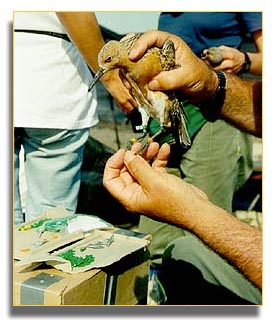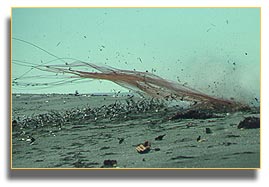|
|
|
|
The first research project to be part of WASA is the International Banding Project which is being led by Professor Allan Baker, Canada and Patricia M. González, Argentina. This project is colour-banding Red Knots (Calidris canutus rufa), Sanderlings (Calidris alba) and Ruddy Turnstones (Arenaria interpres) along the Atlantic coast of the Americas in an effort to establish their migratory strategies. The primary goals of this project are to:
|
|
Geographic Locations The project is working with local scientists, wildlife managers, students and volunteers in four main locations on the flyway: In the Canadian Arctic, a team has spent last two summers searching for breeding Red Knots in and around Southampton Island, Northwest Territories. They recently reported finding a colour-banded Knot at a nest. Read more.... In Delaware Bay, United States, project members and volunteers have been colour banding shorebirds on both sides of the bay in May and June each year since 1995. In Brazil, expeditions have been to the estuaries in southern Brazil which are important stopovers for Red Knots and Turnstones in particular. In Argentina, the project works in collaboration with the Fundación Inalafquen to study shorebirds. Two key areas are Tierra del Fuego, the main wintering area, and San Antonio Oeste which is an important early stopover for Red Knots and Ruddy Turnstones migrating north in March. |
Cannon-netting is the main live capture technique used. Mist-netting is sometimes used. Small flocks are netted and the birds are held briefly in holding containers on site. Captured birds are banded with a uniquely numbered metal band. Study species are also banded with colour flags and bands. Read more....
In addition to banding, birds are measured and weighed, and scored for wing moult and body condition. |
|
Participating Groups and Institutions The following Institutions have participated in the project:
|
|
Funding and Support The project has been operated by funds and support in kind from the following groups and institutions:
|
|
Contacts The project leaders are:
Professor Allan J. Baker
Patricia M. González |
| [ Home page ] | [ Maps ] | [ Data entry ] | [ Education ] | [ Contact Us ] |


